63bkpkr
Silver Member
- Aug 9, 2007
- 4,069
- 4,618
- Detector(s) used
- XLT, GMT, 6000D Coinmaster
- Primary Interest:
- All Treasure Hunting
Possible New Prospecting Site w/GMT & Batpan
Hello Tneters,
Last week I was able to get out for a short look see of a new river canyon. And is it ever scenic!
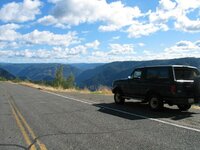
At every turn of the road there are exciting Mountain/Canyon views to take in, my mind was going wild with the beauty before me.
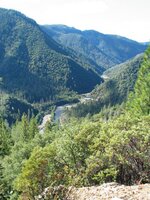
The canyon I'm interested in has a huge number of side canyons coming into it which is why it has so much water in it.
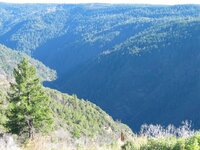
From up on top even catching scant glimpses of the water brought up new questions of what was it really like accompanied by visions of places I'd been in the past.
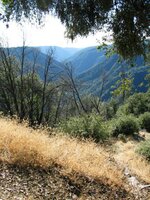
I found an easy trail that took me to the river itself and after a miles hike I dropped right down to the river.
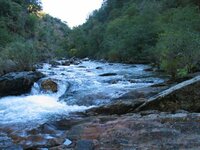
It was so exciting to be there with the roar of the water, the obvious overhead dredge teather cables, the open river bed beneath my feet, the large pools for dredging and so many possible places to prospect staring me in the face.
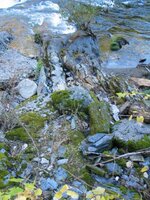
Then I saw my first large quartz outcrop right on the exposed riverbed and then began to see all the quartz rocks in the river.
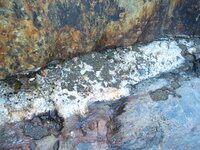
I chose the downriver side of a tree for my first test dig. I knew I was on the wrong side of the river bend but as I was not about to swim to the other side in THAT COLD water, I took what was available.
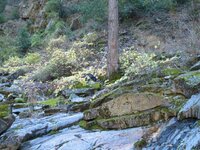
The dig site proved to be mostly silt and fine river gravel and was about what I had expected. The first actual use of the Batpan was exciting and interesting, I used the method the inventor suggests in his video. The magnets work well to collect the black sands keeping it out of the way of washing the rest of the materials. The pan washed clean with no gold in sight, an iron pyrite crystal and LOTS of black sand up on the Pan sides. With some hand pressure the black sand washed off easily leaving the pan ready for the next trial up stream.
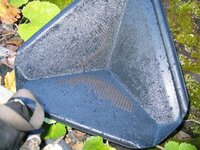
I made my way through the brush, rocks, rock hillside and the usual "stuff" one finds along the sides of any wild river and spotted my 2nd test tree. This one had two main trunks that had captured a rectangular block of stone on the down river side of the tree. Also just behind the captured block was a good selection of various sized river rocks making this a reasonable capture zone. I began to clear the area in preparation for using my GMT.
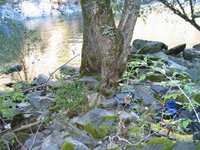
Once some of the medium sized rocks were removed I installed the DD Shooter coil on the detector and began to check the area. The first loud report in the earphones was exciting though it was NOT a zip-zip but I did have a target. I used the prescribed plastic cup method of sorting to look for the target and found it fairly quickly. The target was a large heavily rusted machine thread steel nut showing signs of how large the equipment was that historically has been here. Then another target under the rectangular rock and hung up somewhat in the tree root system. This turned out to be a badly rusted steel something, likely a bolt of some nature. Then almost a zip sound till I cleared away some 4" of dirt/river gravel of various sizes and it became more of a grunt. This was a 1" long piece of small diameter rusted steel.
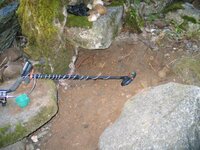 ,
, 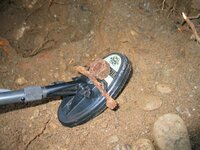
My time was just about up, heavy clouds were rolling in blotting out the sunshine which, for my entire time in the canyon had been on the other side of the river from me. My down coat came out of the pack, I pulled it on over my head and it enveloped me in its warmth trapping slick nylon/down construction. Time for one last pan full of material as I'd gotten a couple of zip-zip sounds from the detector, no time to sort it out by cup. I found a slightly back breaking perch on the river bank and started massaging the clay, rock, dirt combo I had in the pan. I was glad to be wearing those silly looking yellow rubber kitchen gloves as they shielded my hands from direct contact with the cold water. Have I mentioned the water was cold! The silt slid to the surface and over the edges of the pan. The fines quickly settled into the center depression of the cone shaped pan. The heavier rocks were rising to the surface as the pan was rocked/swirled/shaken and eventually the fines stopped discoloring the water. I worked the remaining materials in the central trough by sloshing the water back and forth while allowing the fines to drop over the edge. Again the magnets had removed a large quantity of black sand and held all of it solidly to the pan upper walls. As the last of the fines floated out I spotted one very small flake of gold close to the lowest point in the pan, THE PAN WORKS! I was elated as not all new pans have worked for me but this one proved itself just as soon as I had gold in the pan. Yes it is true, the equipment only works if the prospector finds a spot with gold in it And gathers up some of the gold into the prospectors chosen equipment.
The magnets seem to catch more magnetic material to one side of the pan, I would guess that's because I tend to swirl a pan in a clockwise direction as it was uniform on both the pans of samples from this trip, heavy on one side lighter on the other. I was pleased with the results of the gear I'd brought in with me, the GMT, my two GPS units, my 'old camera' and the new Batpan. However, the clouds were now heavier, darker and more forboding. Knowing that my Vibram Lug soled boots only hold on dry ground I decided to vacate the canyon post haste!
Further explorations will begin next year just as soon as most of the snow and mud are gone. I hope you enjoy the pics and thanks for checking out this little post.
63bkpkr
Hello Tneters,
Last week I was able to get out for a short look see of a new river canyon. And is it ever scenic!

At every turn of the road there are exciting Mountain/Canyon views to take in, my mind was going wild with the beauty before me.

The canyon I'm interested in has a huge number of side canyons coming into it which is why it has so much water in it.

From up on top even catching scant glimpses of the water brought up new questions of what was it really like accompanied by visions of places I'd been in the past.

I found an easy trail that took me to the river itself and after a miles hike I dropped right down to the river.

It was so exciting to be there with the roar of the water, the obvious overhead dredge teather cables, the open river bed beneath my feet, the large pools for dredging and so many possible places to prospect staring me in the face.

Then I saw my first large quartz outcrop right on the exposed riverbed and then began to see all the quartz rocks in the river.

I chose the downriver side of a tree for my first test dig. I knew I was on the wrong side of the river bend but as I was not about to swim to the other side in THAT COLD water, I took what was available.

The dig site proved to be mostly silt and fine river gravel and was about what I had expected. The first actual use of the Batpan was exciting and interesting, I used the method the inventor suggests in his video. The magnets work well to collect the black sands keeping it out of the way of washing the rest of the materials. The pan washed clean with no gold in sight, an iron pyrite crystal and LOTS of black sand up on the Pan sides. With some hand pressure the black sand washed off easily leaving the pan ready for the next trial up stream.

I made my way through the brush, rocks, rock hillside and the usual "stuff" one finds along the sides of any wild river and spotted my 2nd test tree. This one had two main trunks that had captured a rectangular block of stone on the down river side of the tree. Also just behind the captured block was a good selection of various sized river rocks making this a reasonable capture zone. I began to clear the area in preparation for using my GMT.

Once some of the medium sized rocks were removed I installed the DD Shooter coil on the detector and began to check the area. The first loud report in the earphones was exciting though it was NOT a zip-zip but I did have a target. I used the prescribed plastic cup method of sorting to look for the target and found it fairly quickly. The target was a large heavily rusted machine thread steel nut showing signs of how large the equipment was that historically has been here. Then another target under the rectangular rock and hung up somewhat in the tree root system. This turned out to be a badly rusted steel something, likely a bolt of some nature. Then almost a zip sound till I cleared away some 4" of dirt/river gravel of various sizes and it became more of a grunt. This was a 1" long piece of small diameter rusted steel.
 ,
, 
My time was just about up, heavy clouds were rolling in blotting out the sunshine which, for my entire time in the canyon had been on the other side of the river from me. My down coat came out of the pack, I pulled it on over my head and it enveloped me in its warmth trapping slick nylon/down construction. Time for one last pan full of material as I'd gotten a couple of zip-zip sounds from the detector, no time to sort it out by cup. I found a slightly back breaking perch on the river bank and started massaging the clay, rock, dirt combo I had in the pan. I was glad to be wearing those silly looking yellow rubber kitchen gloves as they shielded my hands from direct contact with the cold water. Have I mentioned the water was cold! The silt slid to the surface and over the edges of the pan. The fines quickly settled into the center depression of the cone shaped pan. The heavier rocks were rising to the surface as the pan was rocked/swirled/shaken and eventually the fines stopped discoloring the water. I worked the remaining materials in the central trough by sloshing the water back and forth while allowing the fines to drop over the edge. Again the magnets had removed a large quantity of black sand and held all of it solidly to the pan upper walls. As the last of the fines floated out I spotted one very small flake of gold close to the lowest point in the pan, THE PAN WORKS! I was elated as not all new pans have worked for me but this one proved itself just as soon as I had gold in the pan. Yes it is true, the equipment only works if the prospector finds a spot with gold in it And gathers up some of the gold into the prospectors chosen equipment.
The magnets seem to catch more magnetic material to one side of the pan, I would guess that's because I tend to swirl a pan in a clockwise direction as it was uniform on both the pans of samples from this trip, heavy on one side lighter on the other. I was pleased with the results of the gear I'd brought in with me, the GMT, my two GPS units, my 'old camera' and the new Batpan. However, the clouds were now heavier, darker and more forboding. Knowing that my Vibram Lug soled boots only hold on dry ground I decided to vacate the canyon post haste!
Further explorations will begin next year just as soon as most of the snow and mud are gone. I hope you enjoy the pics and thanks for checking out this little post.
63bkpkr
Amazon Forum Fav 👍
Upvote
0


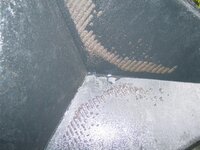
 I'm thinking of just cutting 3" off the top of a bucket just to use for a stand.
I'm thinking of just cutting 3" off the top of a bucket just to use for a stand. 




